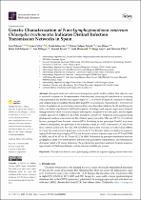| dc.contributor | Vall d'Hebron Barcelona Hospital Campus |
| dc.contributor.author | Piñeiro, Luis |
| dc.contributor.author | VILLA, LAURA |
| dc.contributor.author | Salmeron, Paula |
| dc.contributor.author | Macia, Maria Dolores |
| dc.contributor.author | Otero, Luis |
| dc.contributor.author | Vall Mayans, Martí |
| dc.date.accessioned | 2023-05-09T07:24:24Z |
| dc.date.available | 2023-05-09T07:24:24Z |
| dc.date.issued | 2023-04-08 |
| dc.identifier.citation | Piñeiro L, Villa L, Salmerón P, Maciá MD, Otero L, Vall-Mayans M, et al. Genetic Characterization of Non- Lymphogranuloma venereum Chlamydia trachomatis Indicates Distinct Infection Transmission Networks in Spain. Int J Mol Sci. 2023 Apr 8;24(8):6941. |
| dc.identifier.issn | 1422-0067 |
| dc.identifier.uri | https://hdl.handle.net/11351/9483 |
| dc.description | Chlamydia trachomatis; Genotipado ompA; Comportamiento sexual |
| dc.language.iso | eng |
| dc.publisher | MDPI |
| dc.relation.ispartofseries | International Journal of Molecular Sciences;24(8) |
| dc.rights | Attribution 4.0 International |
| dc.rights.uri | http://creativecommons.org/licenses/by/4.0/ |
| dc.source | Scientia |
| dc.subject | Malalties de transmissió sexual - Epidemiologia |
| dc.subject | Infeccions per clamídia - Epidemiologia |
| dc.subject | Genotip |
| dc.subject.mesh | /epidemiology |
| dc.subject.mesh | Genotype |
| dc.subject.mesh | Sexually Transmitted Diseases, Bacterial |
| dc.subject.mesh | Chlamydia Infections |
| dc.title | Genetic Characterization of Non-Lymphogranuloma venereum Chlamydia trachomatis Indicates Distinct Infection Transmission Networks in Spain |
| dc.type | info:eu-repo/semantics/article |
| dc.identifier.doi | 10.3390/ijms24086941 |
| dc.subject.decs | infecciones por Chlamydia |
| dc.subject.decs | /epidemiología |
| dc.subject.decs | genotipo |
| dc.subject.decs | enfermedades bacterianas de transmisión sexual |
| dc.relation.publishversion | https://doi.org/10.3390/ijms24086941 |
| dc.type.version | info:eu-repo/semantics/publishedVersion |
| dc.audience | Professionals |
| dc.contributor.organismes | Institut Català de la Salut |
| dc.contributor.authoraffiliation | [Piñeiro L] Microbiology Department, Donostia University Hospital-Biodonostia Health Research Institute, San Sebastian, Spain. Sexually Transmitted Infections Study Group of the Infectious Diseases and Clinical Microbiology Spanish Society (GEITS-SEIMC), Madrid, Spain. [Villa L] Sexually Transmitted Infections Study Group of the Infectious Diseases and Clinical Microbiology Spanish Society (GEITS-SEIMC), Madrid, Spain. Microbiology Department, Central University Hospital of Asturias, Oviedo, Spain. [Salmerón P] Sexually Transmitted Infections Study Group of the Infectious Diseases and Clinical Microbiology Spanish Society (GEITS-SEIMC), Madrid, Spain. Servei de Microbiologia, Vall d’Hebron Hospital Universitari, Barcelona, Spain. [Maciá MD] Sexually Transmitted Infections Study Group of the Infectious Diseases and Clinical Microbiology Spanish Society (GEITS-SEIMC), Madrid, Spain. Microbiology Department, Son Espases University Hospital, Palma de Mallorca, Spain. [Otero L] Sexually Transmitted Infections Study Group of the Infectious Diseases and Clinical Microbiology Spanish Society (GEITS-SEIMC), Madrid, Spain. Microbiology Department, Cabueñes University Hospital, Gijón, Spain. [Vall-Mayans M] Sexually Transmitted Infections Study Group of the Infectious Diseases and Clinical Microbiology Spanish Society (GEITS-SEIMC), Madrid, Spain. Unitat d’Infeccions de Transmissió Sexual, Servei de Malalties Infeccioses, Centre de Salut Internacional i Malalties transmissibles Drassanes-Vall d’Hebron Hospital Universitari, Barcelona, Spain |
| dc.identifier.pmid | 37108105 |
| dc.rights.accessrights | info:eu-repo/semantics/openAccess |

 Área privada
Área privada Contacto
Contacto








